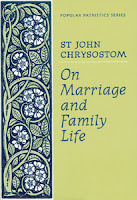One of the highlights of the Patrology course at Saint Charles Seminary is the semester-ending creative presenation and application of a Church Father. The course is part of the required theology core curriculum for all seminarians in the Theological Seminary. The seminarians in various periods of formation (Pre-Theology, First, and Second Theology) worked this semester on Saint John Chrysostom’s On Marriage and Family Life.
In this patristic text, the saintly Father of the Church addressed pertinent topics associated with marriage and family living over the course of four homilies. The seminarians, divided into 4 groups, were charged with using 1 of Chrysostom’s homilies and incorporating that into a setting and application of their choice. Each presentation made good use of technology and some demonstrated great abilities in the use of video and presentation software. Each group prepared a short annotated bibliography for additional spiritual reading and prayer. With a little tweaking, each presentation is ‘ready-to-go’ and can be used easily in parishes and PreCana gatherings.
John (left, Allentown) and Sean (right, Arlington) used Saint John’s homily on 1 Corinthians 7 (Homily XIX) in the setting of a parish retreat for single young adults. As the first group to present, Sean and John gave a brief overview of Chrysostom’s life, noting that he was raised by a single mom who experienced economic hardships; biographical points quite significant given the Saint’s reflections on marriage and family living. Following the biography, John and Sean stressed Chrysostom’s insistance that whether married or celibate heaven is the singular goal of all that is done in this earthly way of living. Creatively, Sean and John used brief video interviews with young adults to sample their descriptions of heaven and marriage. In doing so, the presentation garnered a sampling of views to frame a response grounded in Saint John’s insights. Life ordered to heaven in Christ Jesus repeatedly surfaced in the presentation as the essential virtue for Christian living.
Frank (left, Trenton), August (center, Philadelphia) and Louis (right, Philadelphia) used the occasion of a men’s retreat to sound Chrysostom’s insights on marriage and family living found in Homily XX (Ephesians 5). In an amusing video capturing a meeting of a young man talking with his parish priest about getting married, the presentation initially explored the meaning of Christian love and the challenge such a love has for both marriage and daily Christian living. Linked to Saint Thomas Aquinas’ description of love as ‘to will the good of the other,’ the presentation challenged men to be models of prayer in the family. A life of prayer within the family necessitates prioritizing the responsibilities of life in such a way that one’s eyes are always on Jesus Christ. The group incorporated reflections from Archbishop Chaput wherein he elucidated 10 specific ways to help put life’s demands in proper order. The presentation ended on a summative note focusing on humility as a way of living vital for marriage, family living and indeed the whole of life in Christ.
The ‘Hebrew trio’ David (left, Philadelphia), Jacob (center, Arlington) and Caleb (right, Lincoln) used clips from film and media to survey contemporary approaches to marriage and family living. The group offered a critique of these clips in light of Saint John’s Homily XXI (Ephesians 6) noting his “firm” and “gentle” wisdom concerning marriage and family living. The presentation called attention to Chrysostom’s insistence that family living is essentially a “pattern of life” in which all members of a family, particularly children, are afforded the opportunity to grow in the ‘immaterial goods’ of Divine grace to become not just ‘good or nice’ persons but “holy people” after the pattern of Jesus Himself. While parents have a duty to form children in the natural virtues, it is imperative that children know and strive for the perfection of holiness initially ‘seeing’ such holiness in their parents who live the supernatural virtues. This ‘pattern of holiness’ will assist children to long for lasting and permanent goods reflecting the very life of Jesus.
Jamie (left, Philadelphia) and Alec (right, Lincoln), presenting on Chrysostom’s Homily XII (Colossians 4), showed just how practical and timely the Fathers of the Church can be in offering insight to our present age. In this Homily, Saint John strongly critiqued the wedding receptions of his day for their outlandish practices that did not reflect the dignity of the Marriage Rite celebrated earlier in the day. The presentation noted that Chrysostom certainly affirmed joy-filled celebrations of Marriage but railed against festivities that detracted from the mystery and beauty of Marriage. Employing a number of texts from the Catechism of the Catholic Church, Jamie and Alec demonstrated Marriage’s dignity as a Sacrament and why the Church and Saint John hold marriage in such high regard. The presentation concluded on a note of exhortation to engaged couples to use the time prior to the weddings to grow spiritually as a couple in the Lord.






